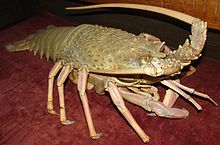- Sagmariasus
-
Sagmariasus verreauxi 
Conservation status Scientific classification Kingdom: Animalia Phylum: Arthropoda Subphylum: Crustacea Class: Malacostraca Order: Decapoda Family: Palinuridae Genus: Sagmariasus
Holthuis, 1991Species: S. verreauxi Binomial name Sagmariasus verreauxi
(H. Milne-Edwards, 1851)Synonyms [2][3] - Palinurus verreauxi H. Milne-Edwards, 1851
- Jasus verreauxi (H. Milne-Edwards, 1851)
- Palinurus huegelii Heller, 1862
- Palinurus tumidus Kirk, 1880
- Palinurus giganteus Kirk, 1880
- Jasus huegelii Ortmann, 1891
- Palinosytus huegelii Stebbing, 1893
Sagmariasus verreauxi is a species of spiny lobster that lives around northern New Zealand, the Kermadec Islands the Chatham Islands and Australia from Queensland to Tasmania.[3] It is probably the longest decapod crustacean in the world, alongisde the American lobster Homarus americanus, growing to lengths of up to 60 centimetres (24 in).[3] The species has many common names in English, including Australian crayfish, common crayfish, common Sydney crayfish, eastern crayfish, Eastern rock lobster, green cray, green crayfish, green lobster, green rock lobster, marine crayfish, New South Wales spiny lobster, packhorse crayfish, packhorse lobster, sea crayfish, smooth-tailed crayfish and Sydney crayfish.[2] In Māori, it is called pawharu.[2] S. verreauxi was formerly included in the genus Jasus, but has been separated into a monotypic genus Sagmariasus due to the lack of sculpturation on the abdomen, which is found in all other Jasus species.[3] The name Sagmarasius derives from the Greek σαγμαριον (sagmarion), meaning packhorse, and the genus name Jasus, in reference to the common name "packhorse crayfish".[3]
References
- ^ A. MacDiarmid, A. Cockcroft & M. Butler (2009). "Sagmariasus verreauxi". IUCN Red List of Threatened Species. Version 3.1. International Union for Conservation of Nature. http://www.iucnredlist.org/apps/redlist/details/170017. Retrieved August 22, 2011.
- ^ a b c T. Chan (2009). "Sagmariasus verreauxi (H. Milne Edwards, 1851)". World Register of Marine Species. http://www.marinespecies.org/aphia.php?p=taxdetails&id=382906. Retrieved May 10, 2010.
- ^ a b c d e Lipke B. Holthuis (1991). "Jasus verreauxi (Green rock lobster)". FAO Species Catalogue, Volume 13. Marine Lobsters of the World. FAO Fisheries Synopsis No. 125. Food and Agriculture Organization. pp. 104–106. ISBN 92-5-103027-8. http://nlbif.eti.uva.nl/bis/lobsters.php?menuentry=soorten&id=134.
Categories:- IUCN Red List least concern species
- Achelata
- Edible crustaceans
- Indo-Pacific crustaceans
- Monotypic arthropod genera
- Marine crustaceans of New Zealand
Wikimedia Foundation. 2010.

